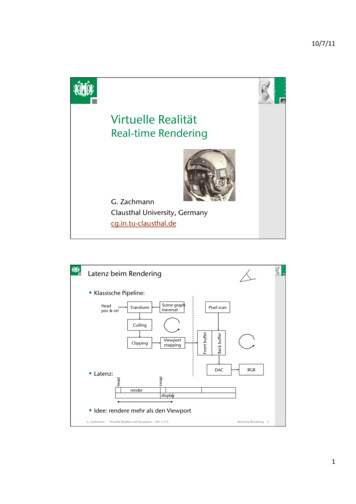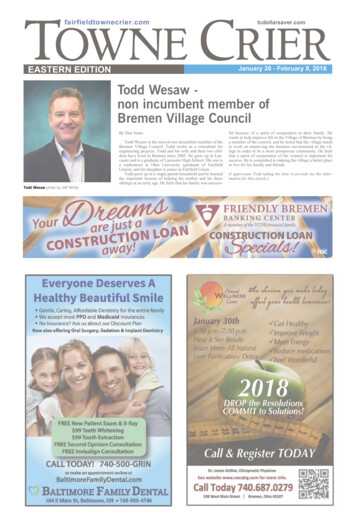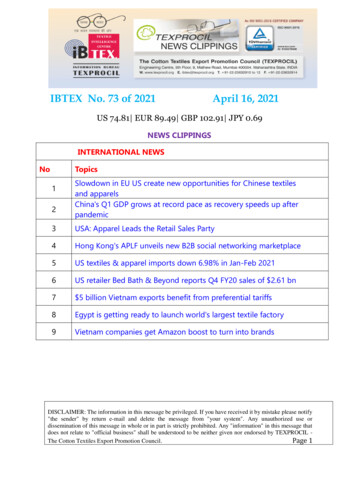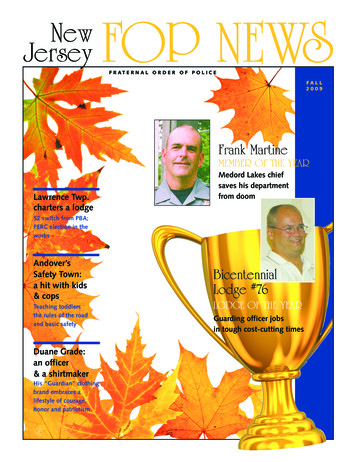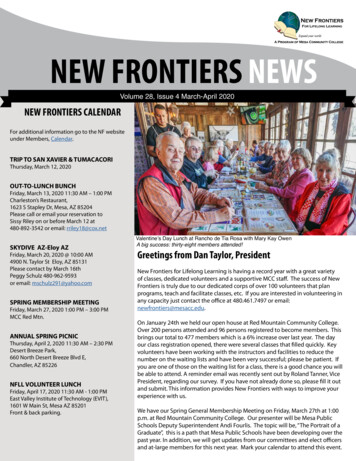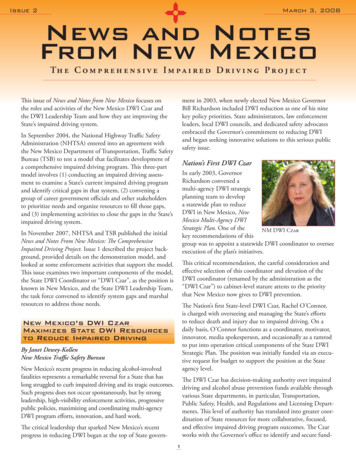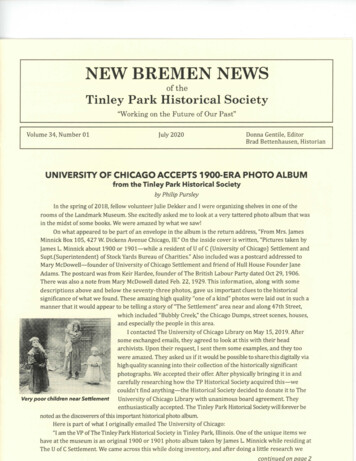
Transcription
NEW B R E M E N NEWSof theTinley P a r k Historical Society" W o r k i n g on the F u t u r e of O u r P a s t "Volume 34, Number 0 1July 2020Donna Gentile, EditorBrad Bettenhausen, HistorianUNIVERSITY OF CHICAGO ACCEPTS 1900-ERA PHOTO ALBUMfrom the Tinley Park Historical Societyby Philip PursleyIn the spring of 2018, fellow volunteer Julie Dekker and I were organizing shelves in one of therooms of the Landmark Museum. She excitedly asked me to look at a very tattered photo album that wasin the midst of some books. We were amazed by what we saw!On what appeared to be part of an envelope in the album is the return address, "From Mrs. JamesMinnick Box 105, 427 W. Dickens Avenue Chicago, 111." On the inside cover is written, "Pictures taken byJames L. Minnick about 1900 or 1901—while a resident of U of C (University of Chicago) Settlement andSupt.(Superintendent) of Stock Yards Bureau of Charities." Also included was a postcard addressed toMary McDowell—founder of University of Chicago Settlement and friend of Hull House Founder JaneAdams. The postcard was from Keir Hardee, founder of The British Labour Party dated Oct 29,1906.There was also a note from Maiy McDowell dated Feb. 22,1929. This information, along with somedescriptions above and below the seventy-three photos, gave us important clues to the historicalsignificance of what we found. These amazing high quality "one of a kind" photos were laid out in such amanner that it would appear to be telling a story of "The Settlement" area near and along 47th Street,which included "Bubbly Creek," the Chicago Dumps, street scenes, houses,and especially the people in this area.1 contacted The University of Chicago Library on May 15, 2019. Aftersome exchanged emails, they agreed to look at this with their headarchivists. Upon their request, 1 sent them some examples, and they toowere amazed. They asked us if it would be possible to share this digitally viahigh quality scanning into their collection of the historically significantphotographs. We accepted their offer After physically bringing it in andcarefully researching how the TP Historical Society acquired this—wecouldn't find anything—the Historical Society decided to donate it to TheUniversity of Chicago Library with unanimous board agreement. TheyVery poor children near Settlemententhusiastically accepted. The Tinley Park Historical Society will forever benoted as the discoverers of this important historical photo album.Here is part of what I originally emailed The University of Chicago:"I am the VP of The Tinley Park Historical Society in Tinley Park, Illinois. One of the unique items wehave at the museum is an original 1900 or 1901 photo album taken by James L. Minnick while residing atThe U of C Settlement. We came across this while doing inventory, and after doing a little research wecontinued on oaae 2
ALBUM continued from page 1realized we had something very uniqueand perhaps historically important.There are over 70 photos that areone of a kind. James L Minnick tookphotos of the people, houses, streets, andplaces of this area including inside the1900 Settlement. There are photos of aGypsy (Roma] encampment at 47th andOgden showing groups and individuals.There are photos of "BubblyCreek" (the south fork of theSouth Branch of the ChicagoRiver, deriving its namefrom the gases bubbling outof the riverbed due to Meatpackers' discarded wasteproducts) and the garbagedump nearby with familiesscavenging through garbage.Roma people at 47th Street and OgdenThere are several photos ofMary McDowell with a group of youngladies perhaps celebrating Christmas.These were taken inside the "House."(HullHouse) All the youngsters including MissMcDowell are holding dolls. There arephotos of boys in the house studying andTHERE ARE playing games and mothers and theirOVER children outside the house posing for aphoto. There is a rather unique photo of70 PHOTOSan African American family sitting andTHATARE standing in front of their house. Thereare street shots with wagons, trainsONE OFA(Illinois Central Railroad near Lake FrontKIND and Rock Island near The Stock Yards),trolley cars, and factories with smokebillowing from smoke stacks causingapparent smog. There is also at the endof this sequence of photos a group ofchildren from "The Settlement" taken atCamp Goodwill in Evanston.In almost all these photos, thephotographer seems to engage with thepeople no matter if they were poor,young or old. These people looking backat us are very much human beings witheach one having a unique story. JamesMinnick definitely related to his subjectsand they to him.This was the email sent to me fromEileen A. lelmini. Assistant UniversityArchivist, Special Collections ResearchCenter on Nov 18, 2019." I can happily report that duringwinter 2020 (January 6-April 24, 2020)we will be highlighting recent additionsto our archives, manuscript and rarebook collections as part of our quarterlyexhibition program. As part of the exhibition the James L. Minnick PhotographAlbum will be on display. We will alsomake the digital copy accessible viaiPads in our exhibition gallery so visitorscan flip through the entire album. TheTinley Park Historical Society will bementioned on an acknowledgmentspanel to all the donors."For more info on The University ofChicago Settlement that Mary McDowellfounded in 1896, search with Google,Wikipedia, or through your local library.Mary McDowell was a personal friend ofJane Addams, founder of Hull House.There is not a lot of info on James L.Minnick. He was born in Ohio circa 1865(perhaps July 1863 in the 1900 Census)and died on Dec 11,1934 in Cook County,living in Brookfield, IL at the time of hisdeath. Mr Minnick shows up in information about Chicago as a personinvolved with charitable organizationsvery often heading them. He may havebeen married twice and perhaps had onedaughter. Hopefully someone will spendsome time researching this man whowas a marvelous photographer and leftChicago a better place during his life.
PHOTOGRAPHYTELECOURSEby John SzatonAt the end of last year I participated ina seven-week telecourse covering theidentification and preservation of photographs. There were approximately fiftypeople from around the country and theworld who were also students. Some ofthem worked in small agencies; othersworked in large photographic artmuseums, which had millions of dollarsof art and preservation equipmentThere were three to four hours of videointeraction per week. Offline required andsuggested readings were also part of thecourse, including semiweekly tests thatkept us on our toes. A packet of samplephotographs was mailed to assist inidentification. The range of study wentfrom 19th century daguerreotypes andsalt prints to 20th century color and then21st century digital photography withdiscussions of laser and Inkjet printing,processes most often used today.Tinley Park Historical Society has alarge number of donated photographs.Many are one of a kind, and of significantsubject matter, from the late 19th and early20th centuries. There is also a plethora ofmore recent photos, some used in localnewspaper articles with many taken bystaff volunteers as documentation of thetown's changes. Some of the photos are ondisplay or cataloged in binders. Many areof unidentified subjects and places; anyrecognition by visitors would be greatlyappreciated. The large number precludesdisplaying all of them. The majority weredonated but unfortunately not marked.The telecourse promoted determination ofthe type of photo, the age and possible location of the scene. The identification processis time consuming, if it is even possible.The course section, which dealtwith precision preservation focused onthe rather expensive equipment and largespaces needed. The gold standard ofpreservation for most photos is "lowhumidity and freezing temperatures".Thus most high-end institutions storetheir originals and display copies onlyallowing limited access to the originalsby professionals. Although TPHS maynot be able to meet New York's Museumof Modern Art standards, preservationis an important objective, and will wecontinue to do our best to preserveour town's history. AN AFTERNOON IN THE OLD SCHOOLHOUSEPresented by theTINLEY PARK HISTORICAL SOCIETY6727 174th Street Tinley ParkDUE TO COVID-19, please call for dateand time of this event.Children in Grades 1st through 8thare invited to observe and experiencewhat being a student was like in an 1800sone room schoolhouse. We have gatheredtogether facts and fun to create a one-of-a-kind learningadventure. As they step back in time the children should beprepared to relive a by-gone era, using chalk boards and slate to"cipher", and a feather quill and ink to practice "penmanship"."Recess" might find them tending the garden, stacking wood forthe schoolhouse stove, playing "kick the can" tag, or jumpingrope. Dried berries and home-made biscuits with jam will serveas a "bite to eat". History will come alive with visits from some ofour very prominent ancestors. Little Eddie Siemsen will displayhis collection of arrowheads found on farm property, theeminent John Rauhoff, inventor par excellence, and the verydistinguished Mr. Samuel Tinley will explain how our towncame to bear his name.This is a complimentary, no charge event limited to the first20 registrants. To register and for more information please call708-429-4210 or 708-257-1353.CALL FOR DATE !
JWLS NATIONAL BARNDANCEBy Ron OttoFrom 1924 to 1959, Saturday nights—for many of us old-timers—consisted ofa bath and listening to The National BarnDance on the radio. The broadcast originated from the Eighth Street Theatre indowntown Chicago. Some of you mightremember the singing "cowboys" Rex Allen,Bob Atcher and Dolph Hewitt from thepost World War II era. But very fewof us are old enough to have heard GeneAutry sing on Chicago Radio WLS beforehe went to Hollywood to make moviesand TV shows.the DeZurik Sisters from Minnesota, theWilliams Brothers from Iowa, includinga young Andy Williams.Another of the early stars was RedFoley whose rendition of "Old Shep"tugged at the heart strings of many alistener as the grieving boy prepared toput the faithful dog out of his misery byshooting him. In the song, the dog diesbefore the boy can do the deed. Montana,Autry and Foley were backed by a quartetof talented musicians— The PrairieRamblers. During the 1930s, The Ramblersconsisted of Chick Hurt, Jack Taylor, TexAtchison and Salty Holmes. By the 1949Family album, the group was composed ofHurt, Taylor, Rusty Gill and Wade RayPost WWII saw a return of performerswho had been in military service, plussome new additions. Rusty Gill returned tojoin The Ramblers and later. The SageRiders. Donald "Red" Blanchard joined thecast as well. By 1950, Captain Stubby (TomFonts) and The Bucaneers provided comicrelief Various performers like The HoosierHot Shots, Pat Buttram, Tex Atchison andSmiley Burnette migrated from Chicago toHollywood, joining Gene Autry in themovie business.Between 1930 and 1957, PrairieFarmer Publications issued the annualphoto magazine, WLS Family Album andAlmanac. Our historic library filescurrently hold issues for 1930, '36, '37,'41-'43, '45 and '47-'55. We welcome alldonations of copies for the missing years.The Family Albums provided photographsof the entertainers who performed onSaturday evening shows and who madepublic appearances at local events andcountry fairs around the Midwest. Annualperformances were regularly held at theIllinois, Indiana and Wisconsin State Fairs.Early stars included: Grace Wilson,Patsy Montana, a young George Gobel,By 1960, Chicago was on the declineas a center for Country and Western music.Nashville was ascending with recordingstudios and The Grand Olde Opry RadioProgram on Saturday nights. Following achange of ownership, WLS began featuringthe "bright new sound" of Rock and Roll onMay 2,1960, which was a radical changefrom its broadcast format for nearly fourdecades. From 1960 to 1969, severalperformers joined a Barn Dance show onWGN Radio Land; and for a couple of years,on WGN television. We welcome readerfeedback on your Bam Dance favorites. Dropus a line or stop in at the museum to viewour collection of "Family Albums."
HAPPY 93rd BIRTHDAY TO HAPPY BETTENHAUSEN,A.K.A. NORMANby Patti Moran Siemsenfrom the memoirs of Happy BettenhausenWhen Happy was born, he was named Norman; but as a one-year-old, his Uncle Henrygave him the name "Happy", and he has been called Happy ever since. Let's "roll out thebarrel" because Happy has reached the young age of 93 years and it's time to do a polka allover town to celebrate this great achievement.Uncle Henry was a local businessman (Bettenhausen Hardware) and very active withthe Businessman's Association and organizing many events in town and asked Happy toplay his accordion at some of these events. "Happy's Polka Band" played at PresidentFord's visit to Joliet in October, 1976; he also played for twelve years at the Klaus BierStube German Restaurant in Frankfort. He also played at the Tinley Park Centennial in1962, the 150-year celebration of the Tinley Park Methodist Church in 2008, and the 150year celebration of the Trinity Lutheran Church in 2009, plus many dances, weddings, andcelebrations at Saenger Hall in Tinley Park.A Little History About HappyIn 1935, during the Great Depression, Happy's family moved to a farm on LaPorte Rd.in rural Mokena. At that time, Happy and Dorothy DeValk were both eleven years old.Dorothy attended Mokena Grade School and Happy attended Frankfort School (Summit Hill).Then came High School: Happy attended Joliet High School and Dorothyattended Thornton. They lost touch with each other until June of 1942, whenHappy was shopping at Vogt's Department Store and learned that Dorothy wasworking there; their relationship blossomed again.In 1944, Happy and Dorothy were married. They raised a family of threeboys. Dorothy went on to Joliet Junior College and received a nursing degree.From 1942 through 1963, Happy and Dorothy operated Happy's BodyShop at 181st and Oak Park Ave. In 1976, Happy moved to a Frankfortdealership where he became an outstanding salesman for Phillips ChevroletHappy's slogan was "Just ask for the guy in the Chevy bowtie". He was the topsalesman for ten years in a row. He worked there for many more years before retiring.On Wednesday, April 24, 2013, Happy Bettenhausen visited us and donated hisoriginal accordion— purchased in 1948—to the Historical Society. It is a HohnerAccordion in its original case. The instrument is in great condition, consideringall the tunes it has played in 65 years! Happy played a polka, and we danced. Healso played My Wild Irish Rose. It was such fun! What an honor to receive thisdonation and a visit from our old friend and long time resident of Tinley Park.Our best wishes to Happy on his 93rd birthday from all his friends at the Tinley ParkHistorical Society. Come visit the Historical Society Museum to see the display of Happy'saccordion and pictures of his band.
BEFORE IT'S GONEBy Patrick Schlomas"Don't it always seem to go / That youdon't know what you've got til it's gone?"once mused folk singer Joni Mitchell on her1970 song, "Big Yellow Taxi." This is, ofcourse, a rhetorical question, and no directanswer is necessary. But we at the TinleyPark Historical Society have chosen tooffer a direct answer anyway: NO! Rightnow volunteers are working to inventorythe entire museumcollection; or, inother words, we'regoing to knowexactly what we'vegot before it's gone.Each item held bythe HistoricalSociety is currentlybeing counted.identified in writing and added to anExcel spreadsheet for quick reference.This project also gives us an opportunityto do a little housekeeping and tidy up thedisplay cases on the museum floors. Of thethousands of artifacts to be inventoried,some may deserve a little more love—perhaps with a new label—some mayneed to be relocated, and a couple itemsmight not even belong at all. But by havinga clearer picture of what the HistoricalSociety has, we can present to visitors aclearer picture of Tinley Park's past.Week by week we get a little closerto having a complete inventory ofmuseum artifacts, and we're eager to havethe museum itself soon looking betterthan ever. Feel free to stop in—by bigyellow taxi or other means of transport—and have a look for yourself GOING TO THE CHAPEL.AND WE'RE GONNA GET MARRIEDDid you know that Tinley Park has a wedding chapel? The Chapel—originally theOld Zion Lutheran Church, built in 1884—is now owned by the Tinley Park District and is alsopart of the Tinley Park Historical Society Museum Campus. Today the facility proudly servesour community as a non-denominational Wedding Chapel.As you enter the Chapel you will see its beautiful stained-glass windows, the uniquedetail of its embossed tin ceiling and walls, and wood accents. The Chapel is charming,quaint and has a perfect "picture book" setting to host auspicious events. The bell from thetower chimes as the Bride and Groom exchange their vows. As guests leave the ceremony,the bell rings again for all to hear.Based on current COVID-19 guidance for social distancing, we will be recalculatingthe capacity of the Chapel for weddings and other events. Please contact us for moreinformation. Flowers on the altar and bows on the pews are included in the rental fee.A Wedding Coordinator will help you at the rehearsal and on your wedding day. Her services arealso included. We have an organ and piano, which may be used. The acoustics in the Chapel are phenomenaland many musical audio presentations have been successfully and beautifully implemented.If you are looking for a "one of a kind" setting with picturesque charm, come and visit us. We are at themuseum every Wednesday from 10:00 a.m. until 2:00 p.m. or the first Sunday of the month from 1:00 a.m. to3:00 p.m. and the 2nd Thursday of the month from 6:00 p.m. 8:00 p.m. and would be glad to provide a tourof the Chapel. Special arrangements, if needed, can be made by calling 708-429-4210. The Chapel and Hall arealso available for showers, birthday parties. Memorial Services, Renewal of Vows, etc.Not getting married but just curious? Come visit us. We love showing off our Chapel and museums.
OUR MILITARY ROOMby Bruce HaffnerTwo years ago, the Tinley ParkHistorical Society created a military roomin the Museum to consolidate our collection of military memorabilia and uniformsinto one display center. Previously, the itemswere scattered in various locations in theSchoolhouse Museum. As the picturesshow, they look better in one place.The oldest uniform belonged toGeorge Rowden, a WWI veteran. He wasone of the early Commanders of theTinley Park American Legion Post 615.The next oldest uniform belonged to 2ndLt. Robert Funk WWII Army Air Corps.Lt. Funk was a POW (Prisoner of War] inGermany before returning to Tinley Park.The other uniforms are a: WWIIWomen's Army Corps—WAC uniform,WWII era nurses' uniform, WWII Marinedress blue uniform, WWII Navy enlisteduniform, Korean War dress jacket thatbelonged to Donald Kuech, plus manyother uniforms belonging to Tinley Parkresidents. Come in and learn more aboutthese uniforms and other artifacts.
MEMORIES: SWINGING BRIDGES & MOONSHINERSby Patti Moran SiemsenI am not quite old enough to remember the days of Prohibition, however, I do remember a funny story about the prohibition days. Many moons ago. Mom (Dorothy Moran] andDad (Robert Moran] and I, went on summer vacations. We usually visited my Mom'sfamily who lived in southern Illinois (Greenfield, II] and later in a tiny country town calledHettick, 111. I loved visiting the country; it was so different than living in a big town.My grandparents did not have electricity or indoor plumbing. It was just a differentworld. We usually spent a week with them, watching Gramma making her biscuits everymorning, cooking on the wood cook stove, and getting water from the well.IWASSCAREDTODEATHEVERYTIMEI MOVEDSO DIDTHEBRIDGEI loved every minute of our vacations. One summer, we decided to go to Look OutMountain, Tennessee. This was a big treat and it was a really fun place to visit. One of theattractions was the swinging bridge, which was suspended about fifty feet over a ridge inthe mountain. My Dad talked me into going across the swinging bridge. What a mistakethat was! I got about half way across the bridge and froze; I could not go the rest of theway. I was scared to death. Every time I moved so did the bridge. Somehow my dad helpedme get across. I don't remember how; I was shaking like a leaf To this day I am scared ofheights, whether they move or not.But back to the story of Prohibition. Dad liked to take little side trips, and so did Mom.We went on a ride in Tennessee through the mountains. We came across a little dirt roadthat wound up a mountain. It looked really inviting so Dad decided to take the roadto see what was there. We drove for quite a while, twisting and turning; we kept goingfurther up until there was almost no road left. All of a sudden, out of nowhere came an oldpick-up truck. A tall man jumped out of the truck; he was dressed in bib overalls and hada shotgun pointed at us. He didn't seem too happy and asked what we were doing upthere. Before my parents could answer I told him we were looking for moonshiners. Didhe know where we could find them? Needless to say, my parents were speechless—the tenyear-old tells all.The man told us to turn our car around and go back down the mountain. Well, my dadbarely had room to turn around on that narrow road, but we got out of there—quick. Wecontinued on our drive, engrossed in talking about our encounter with the moonshiner,when all of a sudden we heard a siren behind us. Dad pulled over to the side of the roadand an officer approached our car He said that we were speeding and was going to give usa ticket. We would have to be back in court in three weeks. Dad explained that we werefrom out of town and it was not possible for us to return to Tennessee in three weeks."Well," the officer said, "I understand your problem. Follow me to the police stationand we'll see what we can do." The police station was in an old store. There was a deskagainst the wall and a couple of folding chairs. The officer told us to have a seat; he wouldbe right back. He then went into the backroom of the store. When he returned, he hadtraded his police officer's hat for a hat that said: "Judge". He called my dad to the front ofthe desk and told him that the fine for speeding would be 10.00 and he could pay it here.Dad paid him the 10.00 and the Judge—also the Police Officer—said, "Case closed." Thisis a true story, believe it or not, and we've had a lot of laughs about it over the years.
VOLUNTEERISM KINDNESSby Julie Del l erIn February the Historical Societywas invited to the Tinley Park Library tospeak about our organization as part oftheir program series celebrating"Random Acts Of Kindness Week". Thelibrary invited several other organizations that were run by volunteers aswell. I have to admit that when I firstheard of the event, I couldn't quite equatehow what we do at the Society fit in with"Random Acts Of Kindness".Our president Ed Siemsen spokefirst, followed by Connie Pavur and thenmyself We talked about the amazingcollection of items that we house in ourtwo museum buildings and what it takesto inventory, display and care for them.We spoke of our Outreach program andthe excellent presentation that PhilPursley spent countless hours creating.We explained how we help people in theirsearch for information about familyhistories or properties. Connie talked aboutour "Day in a One Room Schoolhouse" thatwe hold each year where "Miss Connie"and "Miss Karen" teach some luckychildren what it was like to learn in a oneroom schoolhouse around 1900, completewith visits from our own "Farmer"Siemsen, John Rauhoff, John Poorman andof course, Samuel Tinley. I told themabout Connie's packages for the soldierswhere children visiting the museums canput together a package and vmte a letter tosend off to the men and women serving ourcountry and how every child receives afree book or two for their efforts.Our time to speak was limited so Icould only touch on the tours we offer, theFollow The Flag program, the free vintageChristmas photos and our Holiday OpenHouse weekend. There was so much totell! Our passion was evident and we werewell received. In the process of our talk,and the audience's reaction to us, I realized just how passionate we are here at theSociety. Every week, year after year, ourdedicated volunteers give their time withno recognition, no fanfare, and no paycheck.Maybe it's because we love historyin all its forms or maybe it's the sense ofresponsibility that comes with caring forsuch a vast collection. Whatever our individual reasons are, I know that collectivelywe want people to experience the treasuretrove that is the TP Historical Society.I don't think I would call it randombut an act of kindness, most definitely. IN MEMORIAMHoffman, M.D., William "Bill" F. 78, passed away peacefully on January 27,2020, surrounded by his loving family in Phoenix, Arizona. Born in Chicago, Illinois,he attended Bremen High School before serving in the United States Marine Corps(USMC) during which time he was stationed, among other locations, at GuantanamoBay during the Bay of Pigs Invasion. He proudly lived his entire life by the motto"Semper Fidelis. (Always Faithful)" Upon discharge, he attended Drake University,then St. Louis University School of Medicine, and completed his neurosurgery trainingat the University of Califomia San Francisco. He was inducted into Alpha Omega Alpha(Medical Honor Society), Omicron Delta Kappa (National Leadership Honor Society),Tri Beta (Biology Honor society) and Who's Who in American University and Colleges.He was also a star football player on the Bremen, Drake and the USMC teams.He is survived by his wife, Mariann, daughters, Julie Ann (Michael) Heathcott,Bridget (James) Coking, and Lara (Keith) Gomora, son, Kevin (Julia) as well as 11loving grandchildren: Aiden, Cole, Kaia, Michaela, Logan, Scarlett, Jacquelyn, Will,Amber, Lena and Elise. He was preceded in death by his son, Joseph, brother, Harryand parents,Harryand Marie.Professionally Dr. Hoffman demanded perfection, was well respected by hispeers and did all he could for his patients. He also saved lives away from the hospital,never hesitating to run toward frantic shouts of help from strangers, be it on a youthfootball field, walking through an airport, hiking in the Grand Canyon, or anywhere amedical emergency would arise. These and other actions made him a hero to many.Personally, Bill had a contagious sense of humor and a generous, kind and lovingheart. His favorite pastimes were spending time with his family and staying up todate on the latest medical research. His passion to continually educate himself aswell as others never ceased. He was a devoted husband, father and grandfather. Hecherished his friendships and will be deeply missed by all who knew him. Keepingwith Bill's wishes, there will be no service but rather, a private family gathering inArizona. If you would like to pay tribute to his memory, please do so by performing arandom act of kindness.
RECENT DONATIONSCynthia Palmerfrom the estate of Clara Manzke:Saenger Hall wineglassesEarly photo of Trinity Lutheran ChurchEllen Tometich (a descendent of Francis Harper)Two framed photos of Judge HarperSet of nine plates & cups from Judge HarperMike Egdorf36" Yardstick from Yunker Lawn ServiceGinny LukasiewiczMany lace pieces & vintage clothingChip (Edward) Brauer1974 brochure ground-breaking photosTP Firestation #2 & Architect drawingsSheila & Craig WiesenfarthTwo metal coat racks from lobby ofHollstein School10" X 8' Metal sign from Kirby School36" yardstick-logo D. Yunker Hwy Comm.,Orland Township1980 Hanging rollup movie screenNicole Niebur18" X 24" Sign: TP Jaycees Welcome(American Scrap Metal)Nicholas DeNovaAndrew High School Band Uniform JacketRobert PatrickThree Goebel's Soda Bottle Works bottles1947TP Dairy Milk BottleChicago newspaper 1943Steve WilenskyFollowing items given to him by retiredTP Public Works Employee:1955 Blueprint A&W Root Beer1940 Village water main extension1911 Vogt's subdivision layout1947 Goebel's subdivision layout1947 Uzemack's subdivision layout1964 Blueprint Dog & Suds buildingDaveWidlak1970 TP Chamber of CommercePhone DirectoryRobert Bettenhausenfrom the estate of Milfred C. Bettenhausen:1940,41,42,43,44,45 Thornton Comm.High School Yearbooks1948 Blue Island Year BookAssorted photos of family and otherTinleyresidentsChicago Tribune Sports Newspaper Issues;Cubs win World Series STrump winsPresidencyChicago Sun Times 2019 Bears100 yr celebrationJudy Birdfrom the estate of John (Jack) Bird:Photo of Jack Bird receiving award fromChamber of Comm. for remodeling onhouse at 17108 Oak Park Ave. for State FarmInsurance BusinessEd Za brock!1986 Board Game "Our Hometown Game TP"Yellow windbreaker from TP OctoberfestPinto Lounge 1962 baseball hat & small flagof horse with logo of Pinto LoungeTerry & Bonnie Mager1900 rocking chair from Burt & Kathryn'sFulton home (originally Henry & MatildaVogt's rocker)1914 child's rocking chair from Henry& Kathryn VogtEd & Pat SiemsenEarly 1900 2" round ceramic & brass light switchMarybeth Bishop1980 Political Trustee sign1800s man's stripped shirt and collar1964 Colliers Magazine: tour of white house& Mr. Benny's 40th birthdayDonna Gentile1900s metal nutcracker: image of dogRobert ToveyIn memory of William Papson, 1945 Seth ThomasClock originally hung in TP Post OfficeGail RockrohrZagerfrom the estate of Earl & Virginia Rockrohr:Many kitchen utensils and mixerDaily toiletries, grooming utensils, games,Carnival glass decanters, shot glasses fromGrandparents' Bruening SaloonLadies accessories, 1900 wooden toys24" round wooden cheese containersSheet music & recor
Jul 02, 2021 · can flip through the entire album. The Tinley Park Historical Society will be mentioned on an acknowledgments panel to all the donors." For more info on The University of Chicago Settlement that Mary McDowell founded in 1896, search with Google, Wikipedia, or through y
